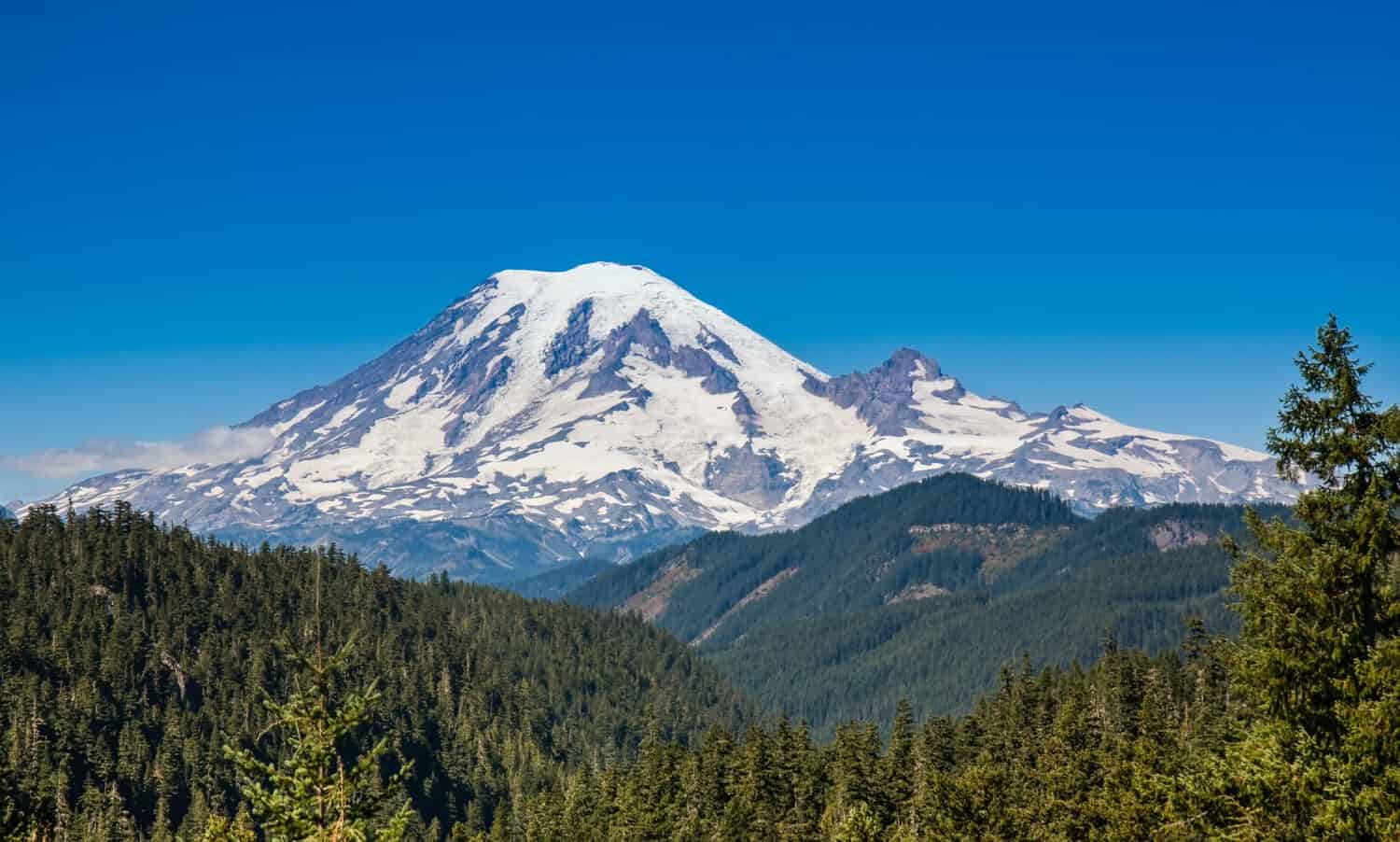The Cascade Range is a chain of mountains that stretches from Northern California into Southern British Columbia. People enjoy these mountains for their awesome beauty and for camping, hiking, skiing, fishing, and other recreational activities. Of course, visitors love to climb these tall peaks, though summitting can be a challenge. Many of the mountains in the Cascades are volcanoes and are actually part of the Pacific Ring of Fire. A number are still considered active, though Lassen Peak and Mount St. Helens are the only volcanoes to erupt in the lower 48 states during the 20th century. Mount St. Helens isn’t in the top 10 highest peaks in the range, though Lassen Peak is. Are you curious about the other nine?
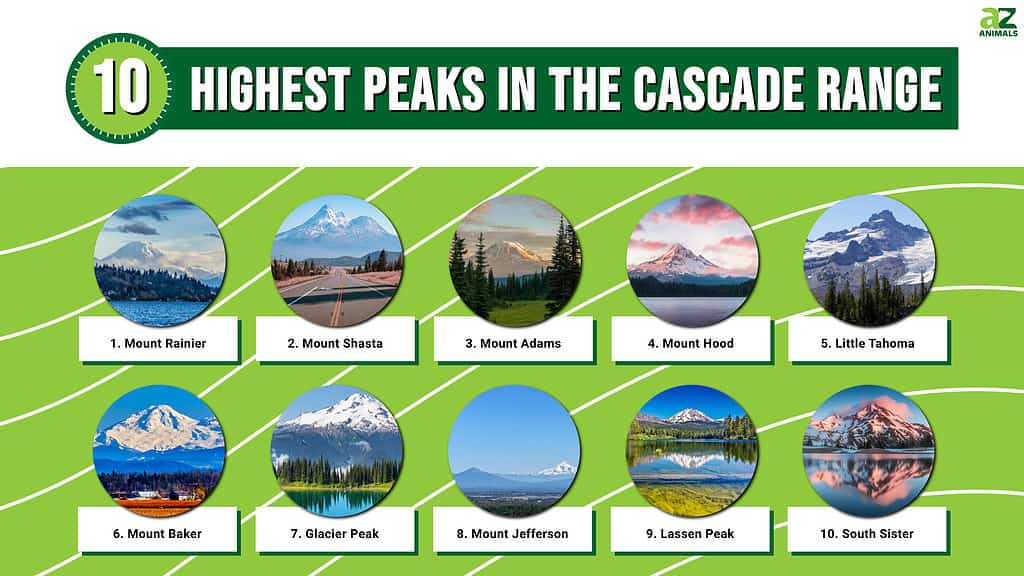
1. Mount Rainier
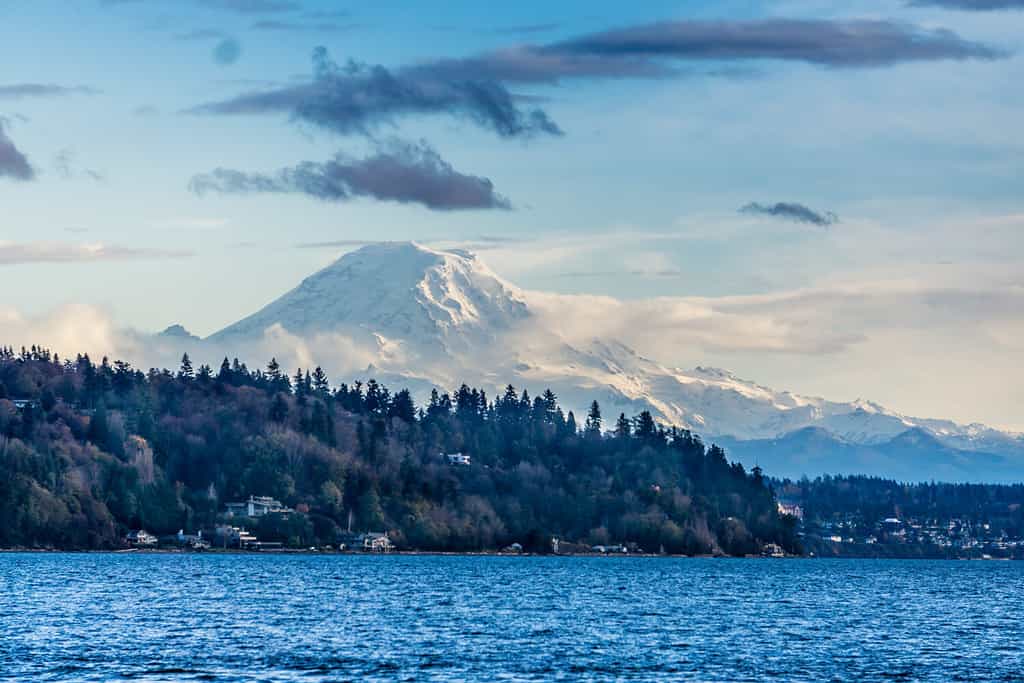
Majestic Mount Rainier towers over Puget Sound.
©GeorgeColePhoto/Shutterstock.com
At 14,411 feet, Washington State’s Mount Rainier is the tallest mountain in the Cascades. It also has at least 26 glaciers, more than any other mountain in the lower 48 states. Mount Rainier is the source of at least five rivers, including the Nisqually, the Carbon, the White, the Puyallup, and the Mowich.
Like most mountains in the Cascades, Mount Rainier is a volcano. Unlike a lot of those other mountains, Mount Rainier is considered active and even dangerous, even though it probably hasn’t had a serious eruption since the middle of the 19th century.
Flora and Fauna of Mount Rainier
The flora and fauna found on and around Mount Rainier are diverse, and some species are found nowhere else like the Cascade red fox. The mountain’s subalpine zone is famous for the abundance and variety of wildflowers. There are also areas of old-growth forest and beautiful stands of firs, cedars, hemlocks, and pines.
Mount Rainier was named by British naval officer and explorer George Vancouver after his friend, fellow Royal Navy officer Peter Rainier.
2. Mount Shasta
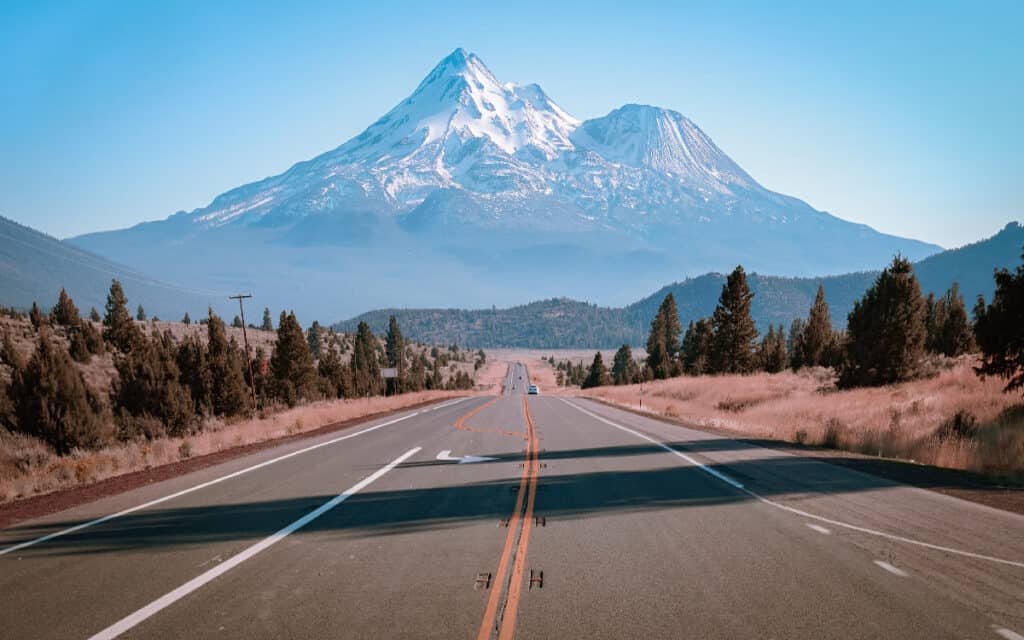
Here’s a view of the Cascade’s Mount Shasta.
©Zach Zheng/Shutterstock.com
California’s Mount Shasta is the second tallest peak in the Cascades at 14,179 feet. Like Mount Rainier, it’s a stratovolcano and is in fact made of four dormant volcano cones, including one named Shastina. Its parent peak is North Palisade. The mountain has seven glaciers, with Whitney being the longest. Others are Bolam, Mud Creek, and Wintun. Scientists believe that Mount Shasta last erupted around 1250, though it grumbles from time to time.
Peter Skene Ogden, who worked for the Hudson’s Bay Company, named the mountain after the Native people who lived around it. The date of the naming was February 14, 1827.
3. Mount Adams
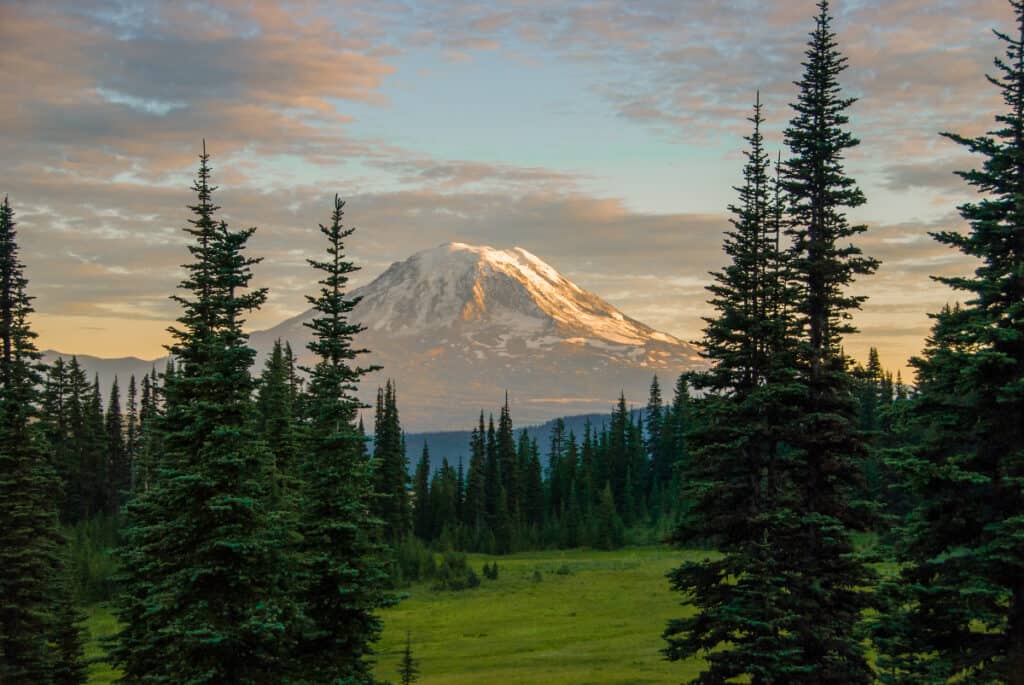
Here’s a stunning view of Mount Adams through a forest of conifers.
©iStock.com/climbbike
The second highest mountain in Washington State behind Mount Rainier, Mount Adams is 12,281 feet tall. It was named in honor of President John Adams. Like Mount Rainier, it hasn’t erupted in a long time but is still considered active. It is the source of many rivers and streams that flow from its glaciers, including the White Salmon River. Mount Adams has 12 named glaciers, including the Adams, Rusk, White Salmon, and Lyman glaciers. The mountain is known for its notably flat peak, which was created from many eruptions from vents in the volcano and not because the mountain’s original peak collapsed.
Like the other mountains in the Cascades, the climate around Mount Adams allows for a great variety of flora and fauna, including hemlocks, cedars and pines, larches, junipers, and yews. Deciduous trees also grow around the mountain. These include oaks, aspens, cottonwoods, maples, and alders. One of the tallest ponderosa pines on earth, the 202-foot-tall Big Tree, is also found around Mount Adams. Wildflowers include monkey flowers, blue-eyed grass, heather, bladderwort, valerian, grasses, and rushes.
Animals that live on the mountain include mountain goats, deer, black bears, bobcats, and the indigenous Cascade Mountain fox. People have even sighted wolves around Mount Adams. The mountain is also home to a wealth of birds, including thrushes, sparrows, finches, eagles, hawks, grouse, owls, and woodpeckers. Streams and lakes are abundant in fish, including different species of trout and salmon.
4. Mount Hood
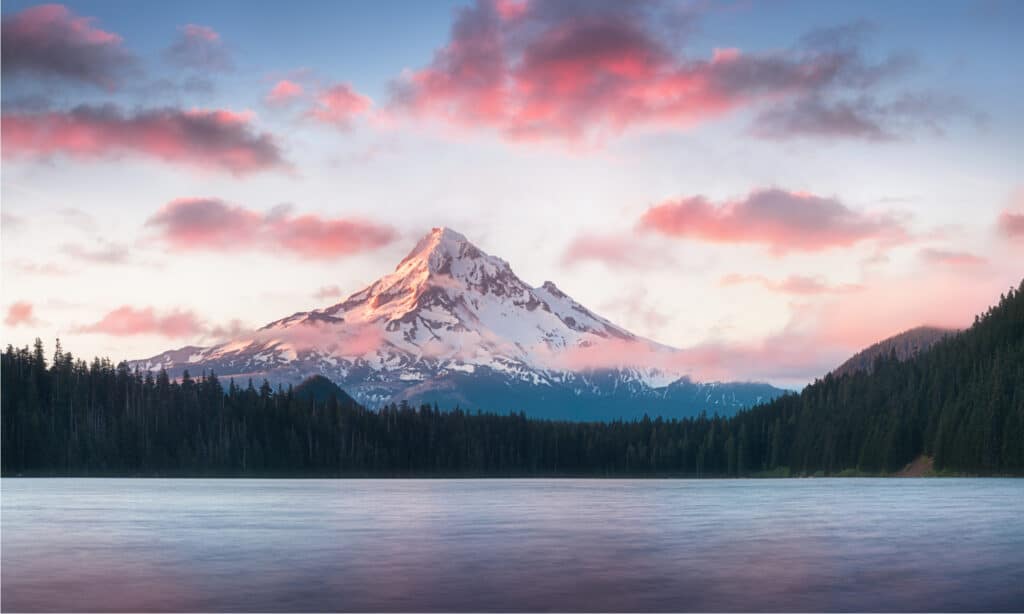
Magnificent Mount Hood rises over Lost Lake at sunset.
©Michal Balada/Shutterstock.com
Oregon’s Mount Hood is the highest mountain in the state at 11,249 feet at last count. For some reason, the state elevation of the mountain has varied wildly over the years. For example, in 1854 Thomas J. Dryer claimed that Mount Hood was an impressive 18,361 feet tall. Some geologists consider Mount Hood an active volcano, while others believe it’s more or less dormant even though it hasn’t had a big eruption since around 1781.
Because its peak is covered with snow all year, it is the home of North America’s only year-round ski lift. It has six areas where you can enjoy snow sports, including Snow Bunny, Summit, and Ski Bowl.
Like the other Cascade peaks, Mount Hood is home to several glaciers and snowfields, including Zigzag Glacier, Palmer Glacier, and Newton Clark Glacier. All of them are the source of or feed into major rivers and creeks, including the White River, the Salmon River, and the Sandy River.
Mount Hood was named for Samuel, Viscount Hood, who was a British Admiral. The honor was bestowed on October 29, 1792, by William Broughton, a naval officer who accompanied George Vancouver on his expedition.
5. Little Tahoma
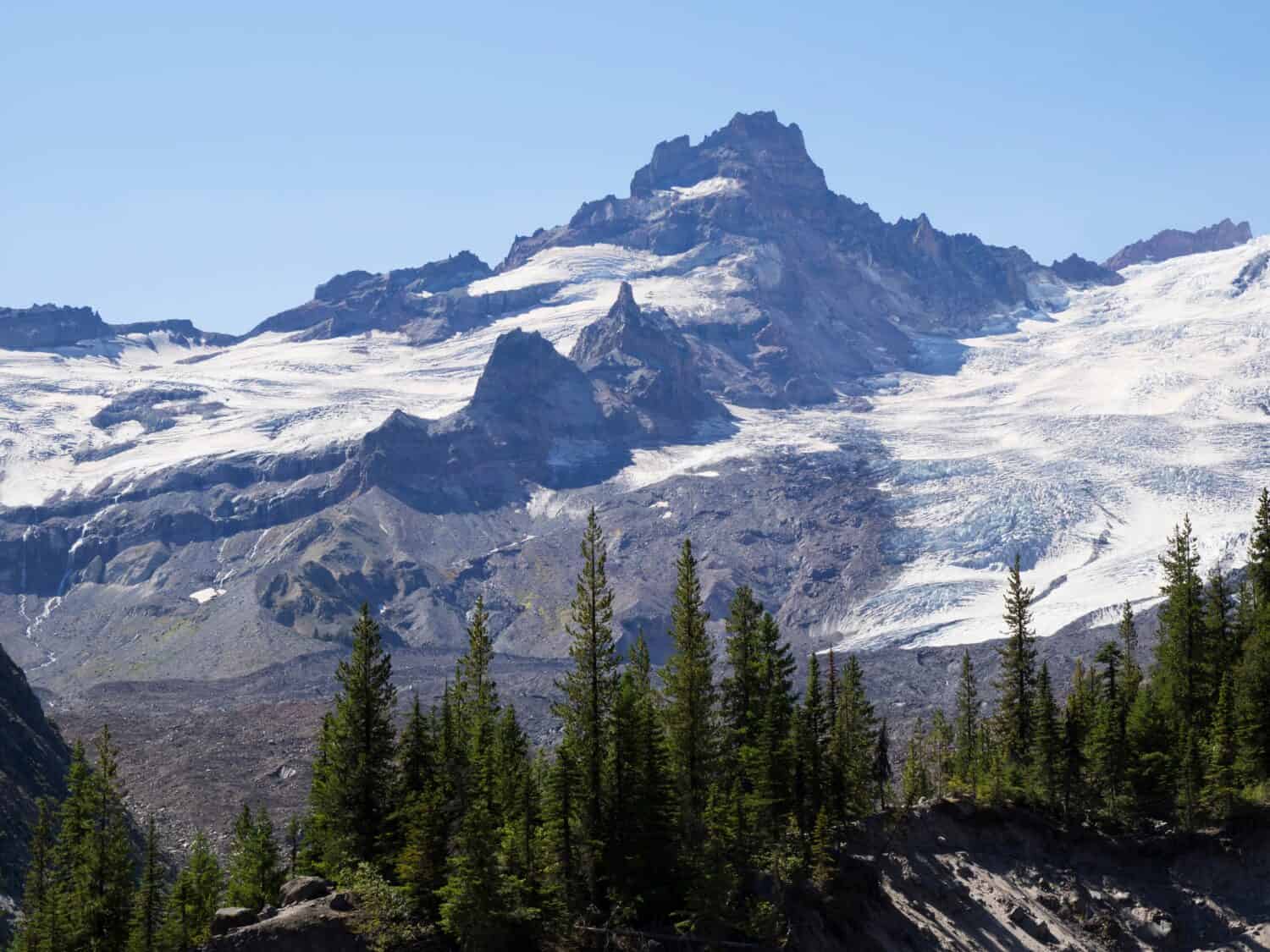
Little Tahoma is part of Mount Rainier National Park.
©Danita Delimont/Shutterstock.com
Tahoma is the name for Mount Rainier, and this 11,138-foot peak is a satellite of it. It was created during a volcanic eruption that eroded away. Because of this, the rock that forms Little Tahoma is crumbly, and rockfalls are a risk. It’s considered an excellent climb for mountaineers with moderate skills. Most climbers come at it from the alpine meadow Summerland.
6. Mount Baker
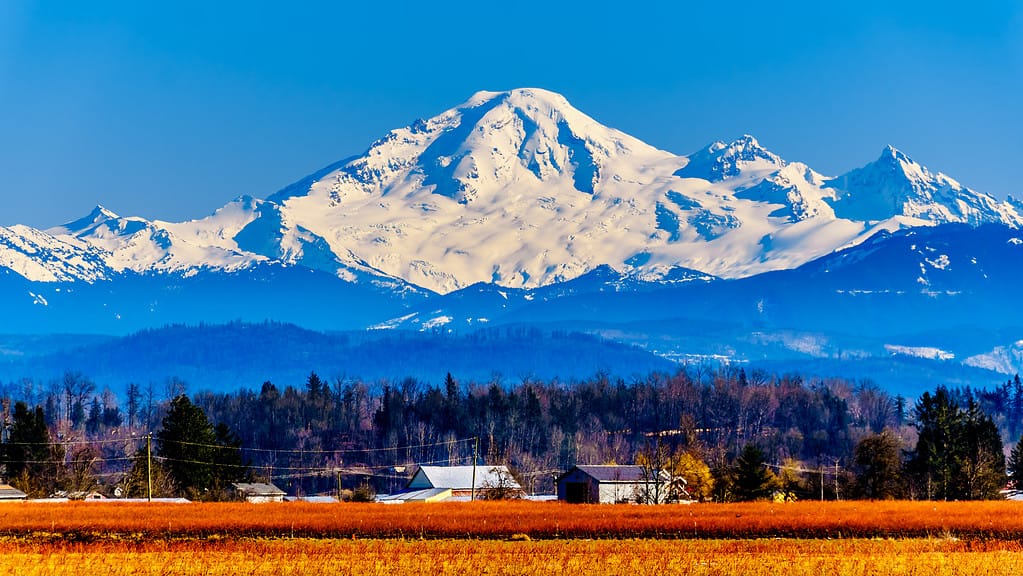
You’ll find glorious Mount Baker in Washington State.
©Harry Beugelink/Shutterstock.com
Also called Kulshan, the 10,786-foot Mount Baker is notably covered with glaciers and gets an amazing amount of snow. In 1999, the Mount Baker Ski Area got an astounding 95 feet of snow in one season. This makes the pure white of Mount Baker’s peak stand out beautifully against the deep blue of the Washington sky.
Mount Baker is one of the Cascade’s youngest volcanoes and has not been very active for thousands of years, though there may have been some ashfalls in the 19th century. There have also been recent avalanches. Today the mountain does emit sulfurous gases from fumaroles.
The mountain holds 11 named glaciers that feed several rivers, including the North Fork and Middle Forks of the Nooksack River.
7. Glacier Peak
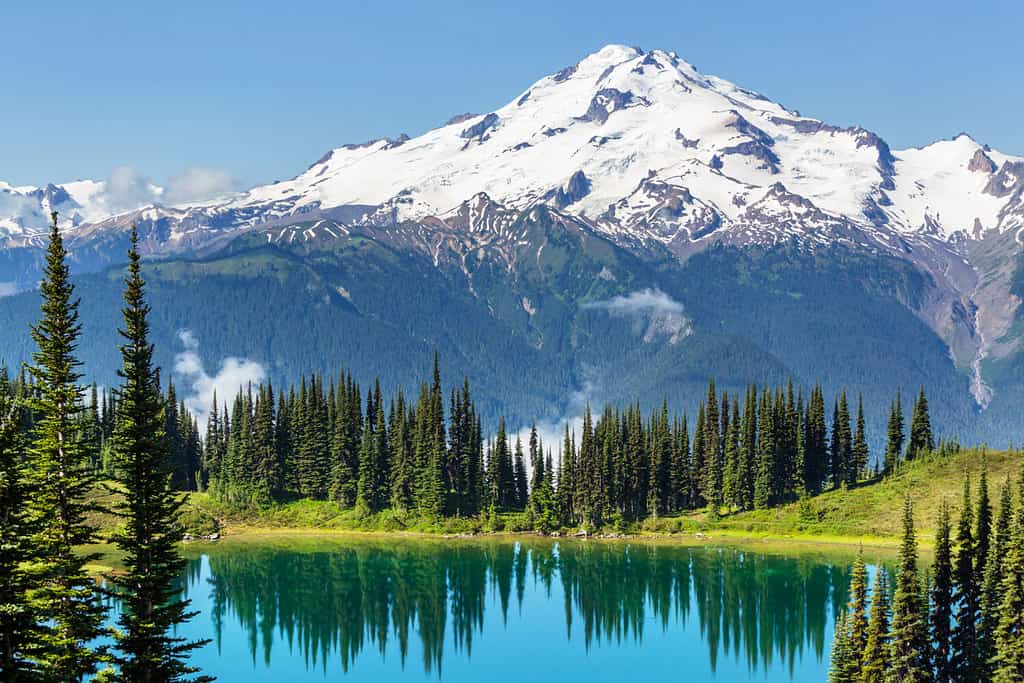
The mountain called Glacier Peak is also known as Dakobed.
©Galyna Andrushko/Shutterstock.com
At over 10,525 feet tall, Glacier Peak is so far away from Washington State’s other stratovolcanoes that not much is known about it. Scientists do know that it’s unusually active and has exploded, rather catastrophically, at least five times in the last 3,000 years. This is pretty frequent when you consider geologic time.
Speaking of glaciers, Glacier Peak has about eleven important ones, and they have been advancing and retreating since the Little Ice Age, which some scientists believe occurred from around the 16th to the 19th centuries. Indeed, one glacier, Milk Lake Glacier, evaporated during the 1990s. The Pacific Crest Trail that stretches from California’s border with Mexico to British Columbia runs past Glacier Peak.
8. Mount Jefferson
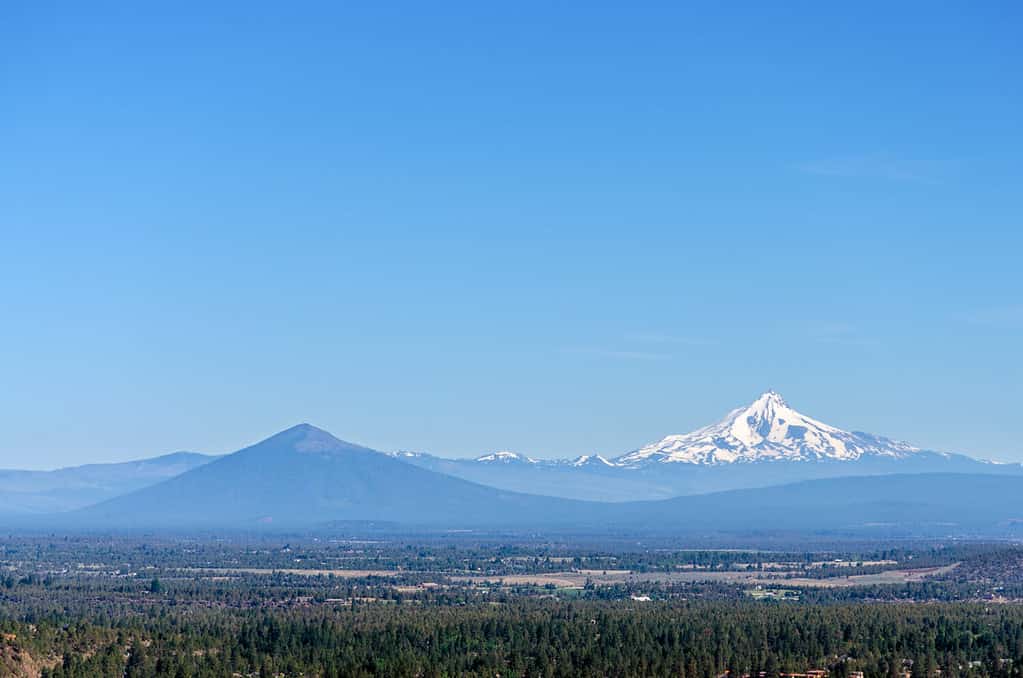
Mount Jefferson is a stratovolcano found in Oregon.
©Structured Vision/Shutterstock.com
One of several Mount Jeffersons found in North America, this one in the Cascade Mountains is 10,502 feet tall and is the second-highest peak in Oregon after Mount Hood. It was, of course, named for President Thomas Jefferson by Lewis and Clark during their expedition to survey the western part of the United States after the Louisiana Purchase. This was fitting since the president sponsored the expedition in the first place.
Like other mountains in the Cascades, Mount Jefferson has an amazingly diverse ecology, with many species of mammals, birds, reptiles, and amphibians. As for trees, conifers such a firs, hemlocks, and pines predominate. Though you won’t find a paved road for at least four miles from the mountain, and you can only get there by walking or on horseback, Mount Jefferson is a popular recreation area. There are many hiking trails and bridle paths, though the mountain is difficult to summit. Only really experienced mountaineers should try.
9. Lassen Peak
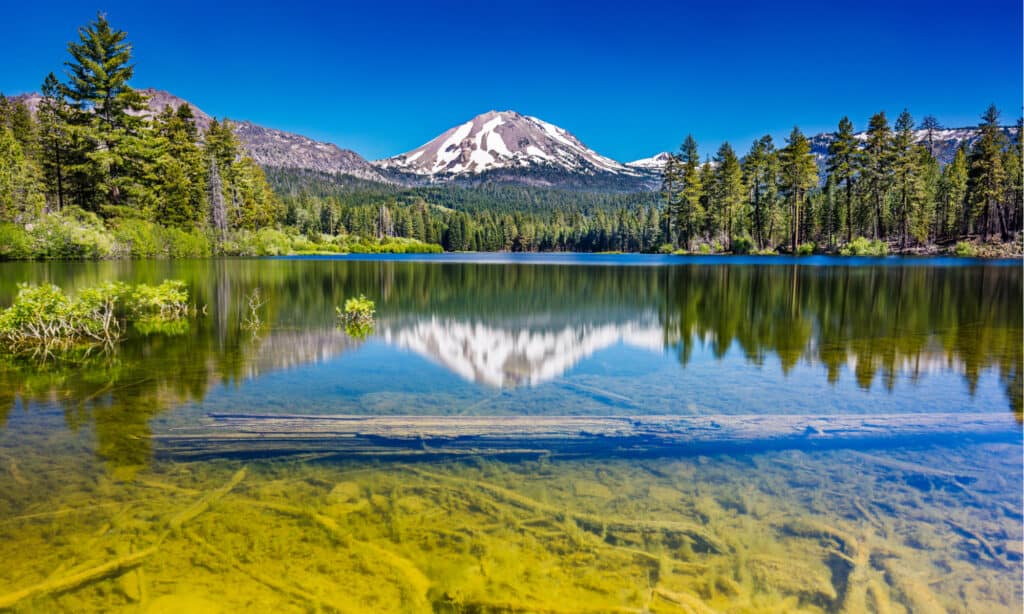
Lassen Peak is only one of two volcanoes to have erupted in the lower 48 states in the 20th century.
©H Peter Ji Photographer/Shutterstock.com
Found in Northern California, 10,457-foot Lassen Peak is a type of still active volcano known as a lava dome. This is a volcano with a mound created over time by lava pumped up from inside the earth but is so sticky that it can’t flow very far or fast. Lassen also differs from the stratovolcanoes of the Cascade in that it erupted violently in the last century, specifically in May 1915. The eruptions didn’t really calm down until 1917. The mountain also gets an amazing amount of precipitation, including snow. In some years, Lassen Peak can get as much as 1,000 inches of snow. However, since it’s in California its peaks aren’t covered with snow as can be seen with Mount Baker. There are only patches where snow is persistent all year long. Lassen Peak is also subject to lightning frequent and powerful enough to start wildfires.
The flora and fauna of Lassen Peak, as with the other Cascade mountains, are diverse and abundant. Again, the trees are dominated by conifers, including ponderosa pines, junipers, and red firs. Smaller plants are those largely associated with California such as manzanitas, mariposa tulips, and chaparral. You’ll also find animals such as black bears, pikas, montane voles, Pacific tree frogs, and cougars. The waters around the mountain support fish such as rainbow trout, fathead minnows, and Tahoe suckers.
In 1907, President Theodore Roosevelt created the Lassen Peak National Monument. Despite the worry that the volcano can erupt again, over 350,000 visit the park and the mountain every year.
10. South Sister
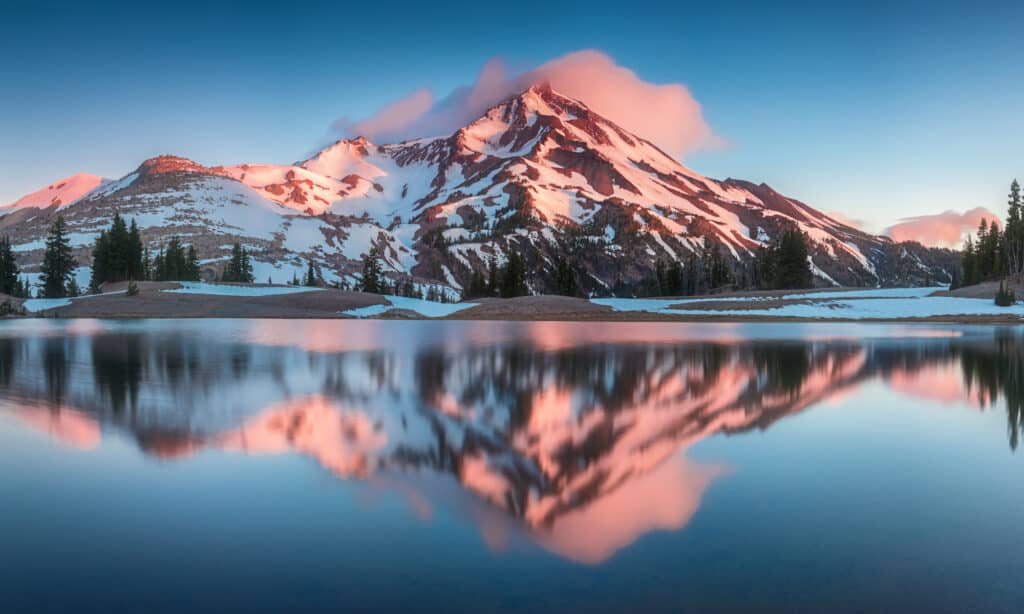
The sun rises over Oregon’s beautiful South Sister Mountain.
©Michal Balada/Shutterstock.com
South Sister is part of the Three Sisters, a trio of volcanic peaks found in Oregon. South Sister differs from the others in that it’s not considered dormant, and it rumbles enough for the United States Geological Survey to keep an eye on it. The informal name for South Sister is “Charity.” North Sister is “Faith,” and Middle Sister is “Hope.” Though they seem very close to each other, each mountain has its own ecology. One thing that differentiates South Sister from the others is that she has a lake in her summit crater called Teardrop Pool. This is the highest lake in the state. South Sister is also the easiest of the Three Sisters to climb, especially in the late summer.
Summary of the 10 Highest Peaks in the Cascade Range
| Rank | Highest Peak | Height | Location |
|---|---|---|---|
| 1 | Mount Rainier | 14,411 feet tall | Washington State |
| 2 | Mount Shasta | 14,179 feet tall | California |
| 3 | Mount Adams | 12,281 feet tall | Washington State |
| 4 | Mount Hood | 11,249 feet tall | Oregon |
| 5 | Little Tahoma | 11,138 feet tall | Washington State |
| 6 | Mount Baker | 10,786 feet tall | Washington State |
| 7 | Glacier Peak | 10,525 feet tall | Washington State |
| 8 | Mount Jefferson | 10,502 feet tall | Oregon |
| 9 | Lassen Peak | 10,457 feet tall | California |
| 10 | South Sister | 10,363 feet tall | Oregon |
Thank you for reading! Have some feedback for us? Contact the AZ Animals editorial team.

